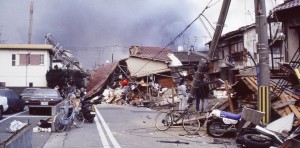
On an ordinary morning in January 1995, the city of Kobe, Japan shook for less than a minute. By the time the tremors subsided, one of the most powerful earthquakes in recent history had already destroyed bridges, expressways and buildings, and within several hours, claimed over 6,400 lives. The quake’s magnitude and the fact that it occurred in close proximity to a highly populous urban center were a deadly combination.
Twenty years later, the international community is meeting in Sendai, a region that has witnessed disasters including Kobe and, more recently, the Fukushima earthquake-nuclear catastrophe, whose after-effects continue to this day. At the third World Conference on Disaster Risk Reduction (WCDRR), they will deliberate on a new intergovernmental framework for disaster risk reduction for the next decade – and a new roadmap for building resilience.
For the past eight years, The Rockefeller Foundation has spearheaded the Asian Cities Climate Change Resilience Network (ACCCRN), an initiative to strengthen the capacity of over 40 cities across Asia to prepare for a range of impacts resulting from climate change and urbanization. We believe that this work offers an important base of experience that can inform the next global disaster agenda, and enrich discussion in Sendai and beyond.
We know that the international framework is only the beginning, and that many other elements will also be critical to building resilience to climate disasters in cities. The factors that will matter are national policy and fiscal commitment, awareness of the need to build risk reduction, and an ongoing assessment of progress. The intergovernmental disaster agenda will also be more effective if it is joined with the climate (COP 21), urban (HABITAT III) and post-2015 sustainable development goals to be refined globally over the course of the next year.
To find a wealth of experience on urban climate change resilience and to learn more about the Asian Climate Change Resilience Network, please visit www.ACCCRN.net. The Foundation-supported program was launched into a network that now welcomes membership from practitioners and institutions who have an interest in exchanging experiences and connecting together to build inclusive and sustained climate change resilience in Asia.
Jim Jarvie is the director of the Asian Cities Climate Change Resilience Network, an effort led by Mercy Corps and supported by the Rockefeller Foundation. He previously served as Mercy Corps’ advisor for resilience, climate and environment, leading strategy development and programming in resilience, climate change and environment. He also led the development of the agency’s global climate change and environment strategy and program as its director, with a particular focus on Southeast Asia. He is a biologist by training, with over 20 years of experience in natural resource management, conservation and conflict.
Anna Brown is a senior associate director at The Rockefeller Foundation, where she manages the Asian Cities Climate Change Resilience Network from her base in Bangkok. She previously worked with the MIT-USGS Science Impact Collaborative. At the Quaker United Nations Office, she led the organization’s engagement with the U.N. Commission on Sustainable Development and guided work on water and conflict. Brown earned her bachelor’s degree in environmental studies from Brown University and her master’s in city planning from the Massachusetts Institute of Technology.
Kimberly Junmookda is a program associate at the Rockefeller Foundation, where she supports the Asian Cities Climate Change Resilience Network. She previously worked at UNESCO where she led work relating to informal and climate change education. At the Institute of International Education, she oversaw a project to enhance food security in Cambodia through capacity building and education. Junmookda earned her bachelor’s degree in international business and French from the University of Redlands and her master’s in education administration and policy analysis from Stanford University.